|
Juniper Mesa 2
The first full Windows device from Juniper Systems
(by Conrad H. Blickenstorfer, with photography by Carol Cotton — to see a capsule version of the Mesa 2 review, click here)
Juniper Systems introduced the Mesa 2 rugged tablet on January 14, 2016. It's Juniper's first handheld to run full Windows — Windows 10 no less — and also the one with the largest display in the company's history. How did this come about?
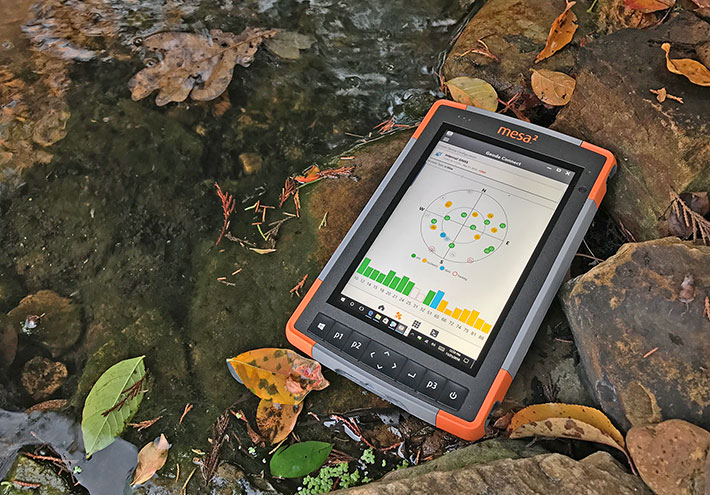
In essence, it's probably pretty simple. Juniper Systems, like most longtime manufacturers of rugged handheld computers, probably witnessed with growing concern Microsoft dragging its feet with updating the legacy Windows Mobile/Embedded Handheld operating environment. As the years went by without any significant progress on Redmond's part, the situation became critical and the pressure grew to get away from increasingly obsolete systems software. Android was an option, of course, but Juniper customers may be too vested in Microsoft IT infrastructures to embrace what many still view as just a phone operating system. So Juniper decided to charge ahead and into uncharted (for them) waters.
What is the Mesa 2?
The Mesa 2 is a full Windows tablet, and it is larger than any Juniper device before. The Mesa 2, however, continues Juniper's tradition of ruggedness and sensible, practical technology. Here's a look at the specs that matter:
- The Mesa 2 runs full Windows 10 whereas all Juniper handhelds before it ran one or another version of Microsoft's Windows Mobile/Windows Embedded Handheld OS for small devices. That's a major step, but one that makes plenty of sense for two reasons. First, smaller devices are now powerful enough to run full Windows. Second, the days of Windows Mobile/Embedded Handheld are finally numbered. In Microsoft's new Windows 10 world, it is being replaced with with special versions of Windows 10. So Juniper is ahead of the game.
- The Mesa 2's 7.0-inch screen is larger than any current smartphone and definitely puts it into the small tablet range. Which is really needed if you want to run full Windows. The 1280 x 800 pixel resolution is super-sharp, right up there with what Apple calls "retina" resolution. We're talking 216 pixels per inch (ppi), far higher than the original Mesa's 140 ppi, and actually sharper than Dell's 24-inch UltraSharp 4k monitors.
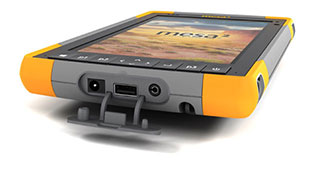
- The Mesa 2 comes with projected capacitive multi-touch. Procap — with its super-easy tapping, panning, pinching and zooming — has taken the world by storm ever since the original iPhone. Procap isn't a natural for Windows, not even Windows 10 (unless you spend most of your time in the operating system's "tablet" view), but the Mesa 2 comes with a narrow-tip stylus which helps a lot. And Juniper says their version is glove and wet-capable.
- The Mesa 2's quad-core 1.33GHz Z3745 processor is part of Intel's well received "Bay Trail" lineup. This chip was specifically designed by Intel to provide full Windows performance in small tablet devices such as the Mesa 2, while still delivering exceptional battery life.
- The Mesa 2's tablet-sized housing allows for significant battery power. The standard 39 watt-hour intelligent Lithium-Ion pack is good for 8-10 hours. An optional internal second 19 watt-hour battery boosts that to 12-15 hours.
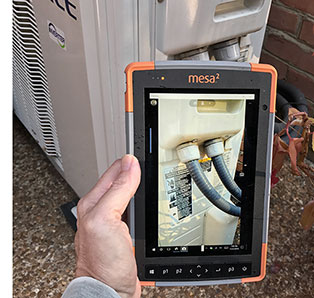 - The Mesa 2 has a wide operating temperature range of -4 to 122 degrees Fahrenheit. While not quite as extreme as that of the company's Archer 2 rugged handheld (which can go as low as -22 degrees Fahrenheit and as high as 140 degrees), this makes the Mesa 2 suitable for deployment in just about any environmental setting, even freezers.
- As far as the ever-popular drop testing goes, the Mesa 2 survives multiple drops from four feet onto concrete. That's again a bit less than the super-rugged Archer 2, but remarkable considering that the Mesa 2 is a larger, heavier device. And four feet is the distance a tablet would drop when in mobile use, so that makes sense.
For ingress protection, the Mesa 2 scores a perfect IP68. That's as high as it gets. The first number stands for protection against solids. 6 means the unit is totally protected against the finest dust. The second number is for the degree of protection from liquids. That scale goes from 0 (no protection) to 8 (totally immune to water, even extended immersion). The Mesa 2 is the only rugged tablet we know of with a certified IP68 rating (Juniper tested at 1.4 meters for two hours). And it's protected even while ports are in use! Now THAT's impressive!
- As is Juniper's custom, the Mesa 2 is available as a standard model and also a special Mesa Geo model. And a Barcode model and an RFID model. All can accommodate Bluetooth 4.0 with enhanced data rate, dual-band 802.11a/b/g/n WiFi and 4G LTE radio of the Verizon or GSM variety. GEO models additionally have a 8.0mp camera with autofocus and Juniper's geotagging, as well as uBlox NEO-M8T GPS with integrated real-time SBAS.
A new field computing machine for a different world
Before we get into details of the Mesa 2's design and construction, it's worth to talk a bit about the significance of Juniper's move.
Tough and rugged handhelds — the likes of which Juniper's core customers have been using for going on a couple of decades — really hadn't changed much in many years. In the early days of handheld computers, most had proprietary operating systems. This changed in 1996 when Microsoft introduced Windows CE. CE was designed to run on minimal hardware with very small displays. For many years, the typical handheld used in the field had a 3.5-inch display with 240 x 320 pixel QVGA resolution. This was good enough to run specially designed software for the field. Palm OS devices were the only competition, and those were primarily for consumers and for business. Once Palm imploded, Microsoft let Windows CE and Windows Mobile (Windows Mobile is essentially a more user-friendly interface with some extra utilities on top of Windows CE) stagnate. That didn't matter too much until the iPhone arrived and showed the world that handhelds could so so much more. And the rest is history.
|
Juniper Systems Mesa 2 vs. original Mesa
|
|
Model
|
Mesa 2
|
Mesa
|
|
|

|
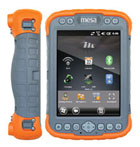
|
|
Introduced
|
2016
|
2010
|
|
OS:
|
Windows 10 (or 8.1)
|
Windows Mobile 6.5.3
|
|
Processor
|
1.33GHz Intel Atom Z3745
|
806MHz Marvell PXA320
|
|
CPU cores/threads
|
4/4
|
1/1
|
|
RAM
|
4GB
|
256MB
|
|
Mass storage
|
64GB or 128GB
|
4GB
|
|
Expansion slots
|
SDXC Card
|
SDHC Card
|
|
Display
|
7.0"/1280 x 800 (216 ppi)
|
5.7"/640 x 480 (140 ppi)
|
|
Digitizer
|
Projected capacitive
|
Resistive
|
|
Battery Life
|
12 to 15 hrs.
|
up to 16 hrs.
|
|
Keypad
|
nav pad + functions
|
nav pad + functions
|
|
Size (inches)
|
5.4 x 8.5 x 1.4
|
5.3 x 7.9 x 2.0
|
|
Weight (lbs.)
|
2.0 (dual batteries)
|
2.2 (dual batteries)
|
|
Sealing
|
IP68 (dustproof and waterproof (tested at 1.4 meters for 2 hours))
|
IP67 (dustproof and limited immersion)
|
|
Temp. range
|
-4° to 122°F
|
-4° to 122°F
|
|
Camera
|
2mp front + 8mp rear
|
3.2mp rear
|
|
USB
|
1 x USB 3.0
|
USB 2.0 host + client
|
|
Serial
|
optional
|
1 x RS232
|
|
Bluetooth
|
v4.0 Class 1.5 (100+ ft)
|
v2.1 Class 1 (65 ft)
|
|
WiFi
|
802.11a/b/g/n
|
802.11b/g
|
|
WWAN
|
4G LTE
|
3G
|
|
Scanning
|
Integrated (scan models)
|
required extended cap
|
Very much to its credit, Juniper didn't idly sit by while all of this happened. Although limited by the constraints of the aging Windows Mobile, the company kept updating its legacy "flashlight-style" Allegro and TK6000 platforms, launched the Archer 2 Rugged Handheld that pushed the old Microsoft Embedded Handheld 6.5 software as far as it could, and in 2010 launched the original Mesa.
Listening to customers dissatisfied with tiny screens, with the Mesa Juniper created a then class-busting much larger handheld that brought Windows Mobile simplicity, instant-on, speed and great battery life to a satisfyingly large 5.7-inch touch screen. Juniper called the first Mesa a "rugged notepad" and described it as a tablet computer without the complexity and overhead of a standard Tablet PC.
With its big display, the original Juniper Mesa was clearly ahead of its time. Windows Mobile came alive on it, it looked better, and it was much nicer to use. The only problem was that Windows Mobile hadn't grown with it, which didn't matter to some customers, but likely left others wanting. We're sure Juniper considered offering Windows 7 at the time, but legacy Windows simply wasn't an option for a 5.7-inch field device.
The changed when Windows 8 arrived in 2012 with its promise of much improved touch functionality. Those claims were premature, and it wasn't until Windows 8.1 came along in 2014 that touch operation on small field computing devices became more feasible. That's likely when Juniper conceived the Mesa 2 — a compact device suitable for use in the field, with a display large enough for full Windows, but not so big as to become unwieldy.
The table to the right shows how the Mesa 2 compares to the original Mesa. At first sight, the Mesa 2 simply looks like a somewhat larger, streamlined Mesa. But looks are deceiving. The operating systems code on the first Mesa goes back to the original Windows CE devices of two decades ago. The Windows 10 OS on the Mesa 2 is Microsoft's latest and greatest and running on going on 500 million PCs worldwide.
Over the decade-plus that we have followed Juniper Systems we've often commented that the company is marching to the beat of a different drummer. They supported their Windows Mobile customers without hedging their best by also offering Android. Android is certainly a very viable option, but knowing that your vendor completely stands behind not only their hardware but also their software makes for trust and good customer relationships. But when the time came to switch gears and offer full Windows in a field device, they did it without waiting for Microsoft to come out with Windows 10 IoT Mobile Enterprise, the replacement of the old Windows Mobile.
As a result, the Mesa 2 runs the same full Windows as the most powerful desktop PC. Mesa 2 customers can run Windows 10 in desktop mode when they want to (like when they are using the Mesa 2 in an office, hooked up to a big monitor) and they can run it in tablet mode when that makes more sense (like in the field with gloves on).
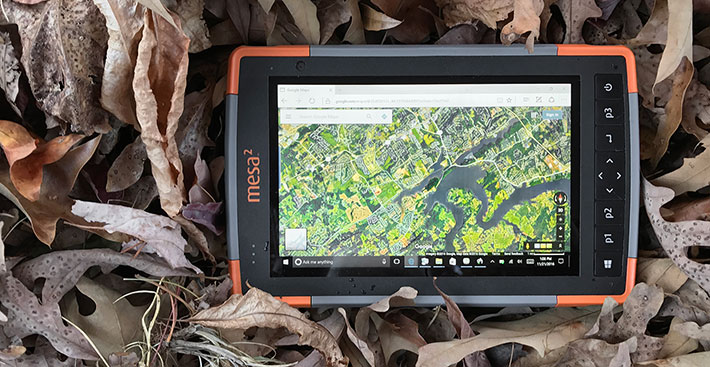
As of late 2016, Juniper still offers the original Mesa. That's likely because the two Mesas aren't in competition. The original Mesa allows users to run legacy Windows Mobile software of which there's still plenty around, and it's tried and true and mature. If it does the job and a customer wants a bigger screen than what your standard handheld has, the original Mesa still makes perfect sense.
The Mesa 2, on the other hand, opens field computing to the world of full Windows 10 with all of its software development, state-of-the-art technology and security, IT leverage, and full compatibility with any standard Windows installation.
A look around the Mesa 2
The Mesa 2 measures 5.4 x 8.5 inches. That's a footprint quite a bit smaller than the standard iPad (6.7 x 9.5 inches) and just a bit larger than the iPad mini (5.3 x 7.9 inches). As an ultra-rugged device the Mesa 2 is quite a bit thicker and heavier than a slender consumer tablet. The standard version of the Mesa 2 weighs about a pound and a half, just like the original iPad did. Our review unit came fully equipped with two batteries and weighed in at two pounds even.
While the original Mesa was somewhat hard to classify with its, for the time, unusually large display, the Mesa 2 is clearly in the small tablet category. But unlike most current tablets, the Mesa 2's labeling and hardware controls show that Juniper designed it to primarily be used in portrait mode. So in that sense, it's still more like a handheld than a tablet.
Materials, colors and design are trademark Juniper — light-gray ABS plastic with orange bumpers. There's no need for a Juniper logo. You know it's a Juniper when you see one just by its color scheme.
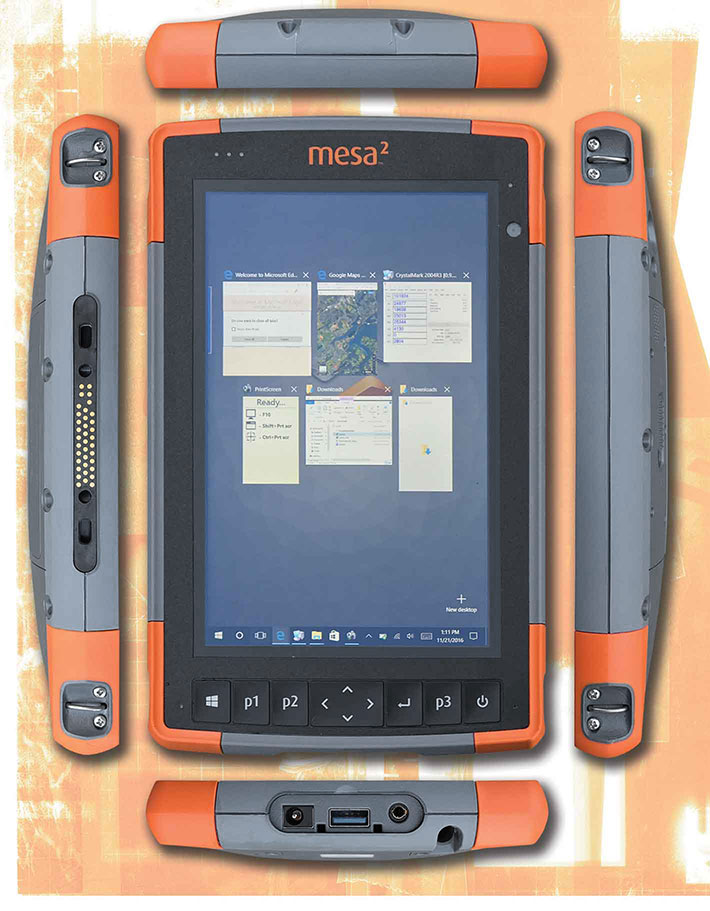
The Mesa 2 doesn't have the visual heft of the original Mesa. Nor does it have that model's imposing magnesium top. Instead, it has the contemporary tablet look with some physical controls added for easiest-possible operation. The buttons are slightly concave so that you can feel with your finger when you're on a button without even looking at the device. And the buttons also provide a comforting link to the past where all handheld PCs had that central navigation diamond and then function buttons to the left and right of it. They still come in handy.
Whereas consumer tablets usually have an all-glass front (which makes it almost mandatory to stick them in a case), as a rugged device the Mesa 2 adds protection with a housing that is slightly raised around the perimeter. But since you don't want a tall, blocky perimeter around a capacitive multi-touch display for your fingers to bop into, Juniper kept the elevation of the protective perimeter at a minimum and made it sloped. Your fingers feel that border, but it won't affect touch operation.
That said, procap displays benefit from having smooth glass go well beyond the perimeter of the actual LCD so you can easily pinch and zoom near the perimeter of the display. Here we'd have liked to see a bit more than the roughly 1/8th inch of extra glass past the LCD before the finger runs into the (thin) plastic bezel.
Like most ultra-rugged and tightly sealed devices, the Mesa 2 has as few I/O openings as possible. Going around the unit, the left side of the Mesa 2 features a surface mount docking connector, and the bottom has a power jack, a full-size USB 3.0 port, a microphone/speaker jack, and a storage slot for the stylus. Other than two hand strap attachment points on each long side, that's it.
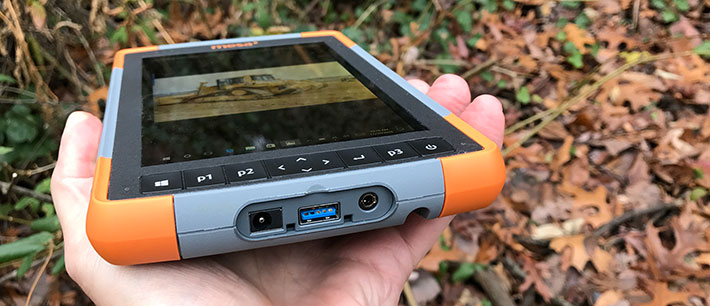
Note that the ports do not a protective plug, cover or door. That's because they don't need it. Technically, they are outside of the Mesa 2 and don't need extra protection to keep liquids or dust out.
Where ruggedness begins: inside the Juniper Mesa 2
When it comes to rugged devices that need to hold up in the field and under the most trying conditions, good looks aren't everything. It's what inside that matters. What materials are used, how things are laid out, and how well the interior is sealed from the outside. And although only very few customers ever see the inside of the mobile computing gear they rely on to do their job, we like to see things as neat and clean on the inside as they are on the outside. Because that tells a lot about the thought and pride that went into creating and making a piece of electronic equipment.
So all that said, let's take a look at the Mesa 2's construction and how it all fits together. The image below shows the backside of the Mesa 2 and next to it the backside with the battery compartment cover removed. Sealing of the compartment is via its plastic cover whose hard plastic lip presses against a replaceable rubber ribbon o-ring seal around the perimeter of the battery compartment. The cover locks into place via a spring-loaded lever. It is not likely that the battery will be released accidentally. The Li-Ion battery of the Mesa 2, sourced from Excell Battery Company, is a square block measuring roughly 2.9 x 2.9 inches and 3/4 of a inch thick. Voltage is 3.65V, amperage 10.6Ah, making for 38.7 watt-hours.
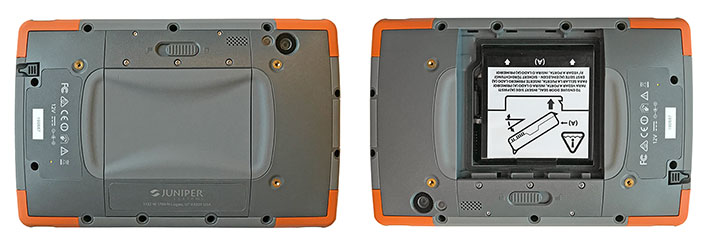
Below on the left is the backside of the Mesa 2 with the battery removed. The battery compartment contains a Micro SIM and a Micro SD card slot. And now we're getting to taking the Mesa 2 apart. The below right picture shows how the four sturdy gray/orange corner bumpers of the Mesa 2 come off after undoing two small Philips screws each. Underneath the bumpers are four anchored metal clips that serve as lanyard loops. They easily pop off. Now there is access to all 11 of the Philips screws that hold the housing of the Mesa 2 together.
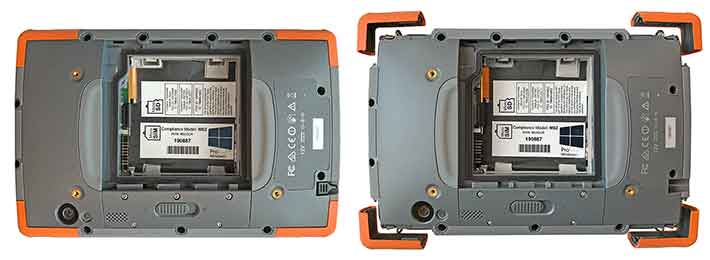
There are no wire connections between the two halves, and the halves separate easily. There are also no clips or tabs that need to be pried apart (and can easily be damaged).
As for the housing material used by Juniper for the Mesa 2, we initially thought it was a generic ABS plastic. We should have known better. It's, in fact, a PC-siloxane copolymer blend that excels at resistance to chemicals and very low temperature impact.
Sealing between the two halves of the Mesa 2 is accomplished with a replaceable light-gray o-ring seal that sits in a complex groove around the entire perimeter of the device. The seal sits loosely in its channel, so carefully examine it before reassembly; improper seating may squash the seal and facilitate leaking.
The top part of the Mesa 2, shown below on the left, contains all electronics and other parts. Structurally it consists of the plastic front half upon which is mounted an intricate magnesium (or aluminum) frame that was quite obviously custom designed for the Mesa 2. The frame is mounted onto the front part of the housing with over a dozen small Torx T5 screws.
The bottom half of the Mesa 2 housing, shown below on the right, contains no electronics or other parts except the tablet's 1 watt/8 ohm speaker with surface mount contacts, and a metal tube that serves as the unit's stylus garage. The speaker is sealed to the outside with a thick bead of white silicone glue.
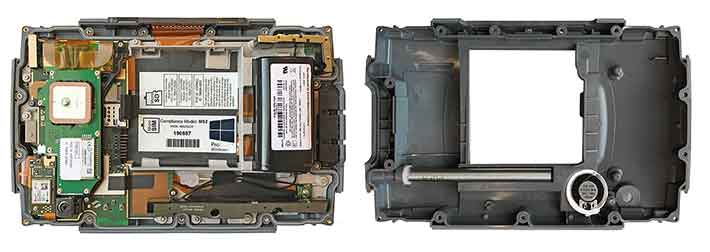
Now let's take a closer look at the circuits and components. Prominent is the Mesa 2's (optional) internal 3.65V/5.3Ah/19.35 watt-hour Li-Ion battery. Combined with the replaceable externally accessible 38.7 watt-hour battery, this means a combined total of 58 watt-hours of battery power. That's a lot for a small tablet. More, in fact, that many large tablets and even laptops have.
A lot of the connectivity inside the Mesa 2 is done via Amphenol interconnect components. If you haven't heard of Amphenol you're not alone. The company has quietly been making all sorts of interconnect products since 1932.  They have 45,000 employees and 2015 sales of US$5.5 billion, i.e. almost as much as the entire worldwide market for all rugged computing products which, according to VDC, is about US$6 billion (if you're interested, here's the catalog of what Amphenol makes). From what we can tell, Juniper took advantage of Amphenol's expertise in LDS antenna component manufacturing, though we're not sure if these are actual LDS (laser direct structuring) components, or if the 3D molded constructs are just the mounting surfaces for antenna foils.
They have 45,000 employees and 2015 sales of US$5.5 billion, i.e. almost as much as the entire worldwide market for all rugged computing products which, according to VDC, is about US$6 billion (if you're interested, here's the catalog of what Amphenol makes). From what we can tell, Juniper took advantage of Amphenol's expertise in LDS antenna component manufacturing, though we're not sure if these are actual LDS (laser direct structuring) components, or if the 3D molded constructs are just the mounting surfaces for antenna foils.
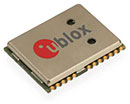 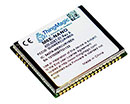 Also prominently visible are the embedded M6E Nano UHF-RFID reader (see spec page) module from ThingMagic, which is a brand of JADAK, and the u-blox NEO-M8N GNSS module for positioning. Also prominently visible are the embedded M6E Nano UHF-RFID reader (see spec page) module from ThingMagic, which is a brand of JADAK, and the u-blox NEO-M8N GNSS module for positioning.
A noteworthy feature of about the M8N is that it can track up to three of the four available GNSS systems concurrently, those being GPS (the US system), GLONASS (the Russian version of GPS), the European Galileo, and the Chinese BeiDou. The ability to track three of those systems means potentially triple the number of available satellites, making for quick starts, very good accuracy, and superior coverage.
As far as I/O goes, external ports are often a weak point in the sealing of a device, because the sealing entirely relies on whatever port protection there is via covers or rubber plugs. Juniper knows that and came up with a different solution: the ports are actually outside of the inner, sealed part of the Mesa 2. That means that only the flat ribbon cables connection the ports to the interior of the device must be sealed, which is much easier and far less prone to leakage. Separating I/O from the motherboard also means that Juniper can easily change the I/O block (updates, replacement of damaged, customized options).
The Mesa 2's system board itself is very compact, just 4.5 x 2.5 inches. That's very small for a full Windows PC board, smaller even than almost all embedded system board standards. Juniper conceivably could have gone with one of the embedded systems board form factors, but those generally need a carrier board, which ruled that approach out for a very compact tablet. So with most standard PC components and modules still being relatively large (as compared to fully integrated components), Juniper stacked components and subsidiary boards, connecting them with some of the neatest custom ribbon cables we've seen. Yes, with the exception of two or three single antenna wires, there is no visible wiring inside the Mesa 2.
Powered by Intel Bay Trail
We imagine it must have been quite a challenge for Juniper's engineers to decide on what processor should power their first-ever full Windows device. Whereas almost all Windows Mobile handhelds used one of a very small selection of processors, Intel's lineup of processors for full Windows is gargantuan. There are roughly a thousand different CPUs available. So they had to figure out how much performance the Mesa 2 would need to get the job done, not really knowing what all customers might load onto their devices.
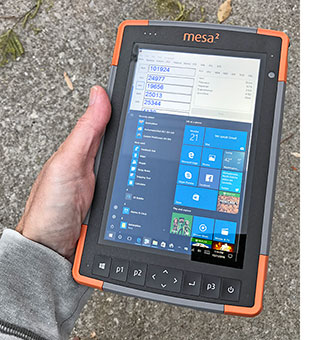 After all was said and done, Juniper decided on a chip from Intel's selection of Atom processors for smartphones and tablets. So the Mesa 2's computing power comes from a 1.33GHz quad-core Intel Z3745 CPU that can reach burst speeds up to 1.86GHz. It belongs to Intel's "Bay Trail" platform that employs 22nm process technology and represents a major After all was said and done, Juniper decided on a chip from Intel's selection of Atom processors for smartphones and tablets. So the Mesa 2's computing power comes from a 1.33GHz quad-core Intel Z3745 CPU that can reach burst speeds up to 1.86GHz. It belongs to Intel's "Bay Trail" platform that employs 22nm process technology and represents a major 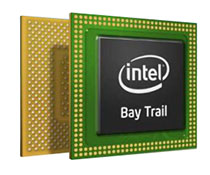 advance in Atom microprocessor design. Note that what Intel calls turbo boost in its high-end Core processors is called "burst frequency" in the Bay Trail lineup. advance in Atom microprocessor design. Note that what Intel calls turbo boost in its high-end Core processors is called "burst frequency" in the Bay Trail lineup.
Compared to Intel's early Atom processors used in all those millions of netbooks that flooded the market before tablets took over, the newer generations of Atom chips are remarkably more powerful and easily capable of running full Windows at a brisk pace. These new Atom chips actually offer more performance than high-end (and much more expensive) Core processors of just a few years ago.
To see how the quad-core Z3745 fares in the Juniper Mesa 2, we used Passmark Software's PerformanceTest 6.1 that runs about 30 tests covering CPU, 2D graphics, 3D graphics, memory, and disk and then computes scores for each category and an overall PassMark score. We also ran our secondary standard benchmark suit, CrystalMark. For comparison, we're listing our benchmark results for a variety of other compact rugged tablets RuggedPCReview has recently tested. Note that these are for the most part not direct competitors. In vertical markets each device has its target deployments and target audience and is configured accordingly. The results are as follows:
|
Juniper Mesa 2 Benchmarks and Comparisons
|
|
PERFORMANCE COMPARISON
|
Juniper
|
ARBOR
|
Handheld
|
MobileDemand
|
Trimble
|
Xplore
|
|
Model
|
Mesa 2
|
Gladius G0975
|
Algiz 10X
|
Flex 8
|
Kenai
|
Bobcat
|
|
Processor Type
|
Intel Atom
|
Intel Celeron
|
Intel Celeron
|
Intel Atom
|
Intel Atom
|
Intel Atom
|
|
Processor Type: Intel
|
Z3745
|
N2930
|
N2930
|
Z3775
|
Z3735F
|
E3845
|
|
Code name
|
Bay Trail
|
Bay Trail
|
Bay Trail
|
Bay Trail
|
Bay Trail
|
Bay Trail
|
|
Thermal or Scenario Design Power
|
2.2 watts (SDP)
|
4.5 watts (STP)
|
4.5 watts (STP)
|
2.0 watts (SDP)
|
2.2 watts (SDP)
|
10.0 watts (TDP)
|
|
CPU Clock
|
1.33/1.86GHz
|
1.83/2.16GHz
|
1.83/2.16GHz
|
1.33/1.83GHz
|
1.33/1.83GHz
|
1.91GHz
|
|
CPU Cores/Threads
|
4/4
|
4/4
|
4/4
|
4/4
|
4/4
|
4/4
|
|
Graphics
|
Intel HD
|
Intel HD
|
Intel HD
|
Intel HD
|
Intel HD
|
Intel HD
|
|
CPU Mark
|
1,863.5
|
2,202.7
|
1,555.2
|
1,589.5
|
1,115.1
|
1,924.9
|
|
2D Graphics Mark
|
117.9
|
160.2
|
177.6
|
178.2
|
112.7
|
149.2
|
|
Memory Mark
|
358.7
|
411.4
|
424.3
|
421.1
|
283.2
|
397.1
|
|
Disk Mark
|
917.2
|
1,257.0
|
2,121.3
|
288.0
|
902.7
|
2,513.9
|
|
3D Graphics Mark
|
148.3
|
141.6
|
142.0
|
147.4
|
99.2
|
158.0
|
|
Overall PassMark
|
785.5
|
959.6
|
962.4
|
605.2
|
560.3
|
1,133.8
|
|
ALU
|
24,977
|
28,174
|
28,563
|
29,126
|
20,734
|
25,808
|
|
FPU
|
19,656
|
24,954
|
24,142
|
24,532
|
17,523
|
21,815
|
|
MEM
|
25,013
|
22,166
|
21,371
|
25,540
|
19,712
|
25,613
|
|
HDD
|
25,344
|
27,245
|
32,575
|
10,649
|
24,812
|
36,177
|
|
GDI
|
4,130
|
5,319
|
6,009
|
5,584
|
3,790
|
4,931
|
|
D2D
|
2,800
|
4,034
|
3,918
|
3,527
|
2,800
|
3,616
|
|
OGL
|
2,804
|
3,796
|
3,688
|
3,454
|
2,448
|
3,305
|
|
Overall CrystalMark
|
104,724
|
115,688
|
120,266
|
102,412
|
91,819
|
121,265
|
The results show that the Mesa 2 is right in the thick of things performancewise, with bottomline benchmark figures that are better than those of a full-size, high-end rugged laptop of a few years ago.
For those Juniper customers new to full Windows on field computing devices, note that it's not just about how many cores the processor has, or what it's clock frequency is. With solid state storage having largely replaced rotating hard disks in mobile devices, the type of solid state memory is becoming quite important.
Superior gas mileage
This being Juniper's first foray into creating a full-Windows device, picking the optimal processor was just one of the many engineering tasks. Making sure that the battery would last a good long time was another. This was especially important as Juniper customers, used to very long run times on their earlier Windows Mobile-powered handhelds, would frown upon mediocre battery life from a shiny new Mesa 2.
Battery technology has advanced quite a bit from the early days of handheld computers, but finding the right balance performance, battery life, size, and weight remains a challenge. Fortunately, the rugged device market is far more reasonable when it comes to accepting a bit of extra size and weight if it serve a purpose, and Juniper has always made sure their handhelds have properly sized batteries.
 As stated above, the Mesa 2 comes standard with a removable, rechargeable 39 watt-hour Lithium-Ion battery the company says is good for 8-10 hours of operation. An optional internal 19 watt-hour battery makes the external battery hot-swappable and makes for a combined 58 watt-hours. That's laptop territory. As stated above, the Mesa 2 comes standard with a removable, rechargeable 39 watt-hour Lithium-Ion battery the company says is good for 8-10 hours of operation. An optional internal 19 watt-hour battery makes the external battery hot-swappable and makes for a combined 58 watt-hours. That's laptop territory.
Our test unit came with both batteries, so in order to continuously run ten hours on a charge, our Mesa 2 should have a power draw of no more than 5.8 watts. To see if that was doable, we tested the Mesa 2 with PassMark's BatteryMon 2.1 utility.
With the tablet set to the Windows "Balanced" power plan and with the display backlight set to its brightest setting, we saw a power draw of just three watts. With the backlight set to medium, the draw dropped to 2.25 watts, and with the backlight set to its lowest setting, power draw dropped to a stunningly low 1.5 watts.
These figures are amazingly low, but they only represent the power draw with the computer idling along. How does it do with heavy load. To test that we ran full 1080p MP4 high definition video, and cranked up the screen to 100%. The Mesa still only sipped 3.5 watts. That would mean about 16.5 hours of uninterrupted use, surpassing Juniper's spec sheet estimate of 12-15 hours with both batteries. The Mesa 2's (excellent) manual says that "battery life on a full charge can be 20 hours or more" and our power draw testing would support that.
These power draw figures are excellent. It means that Juniper skillfully took advantage of all power conservation measures offered by both Windows 10 and the Intel chip. That cannot be taken for granted; we've tested many devices that should have been running economically, but did not.

Display
Now let's talk about the display, the way touch is implemented in the Mesa 2, and how well it all works in real life and out there in the field.
The screen itself measures 7.0 inches diagonally. As already mentioned in the introduction, it has 1280 x 800 pixel resolution which makes it "retina"-sharp. The display's 216 pixels per inch makes it much sharper than the original Mesa's 140 ppi screen, and it's sharper than most of the big 4k desktop monitors. 1280 x 800 pixel makes for a 16:10 aspect ratio, a happy medium between the almost squarish looking iPads and the long and skinny 16:9 tablet displays.
Brightness is important, but it's not everything. A screen backlight can be so bright that it washes out the display (and quickly drain the battery in the process). What matters at least as much as brightness is how well the display outdoors and in sunlight. That requires reducing the reflectivity of the display via polarizers, coatings, and reducing the number of reflective surfaces within the layers of your typical LCD assembly as much as possible. That's done via direct bonding of layers. Juniper lists the display as "outdoor viewable" but doesn't include a nits rating.
All the outdoor pictures in this report are undoctored and that already provides a good idea of how well the Mesa 2 display works. To see how it fares against another excellent display, we did some side-by-sides with a 7000 Series Dell Venue 8 tablet we use around the office. The 8.4-inch Dell consumer tablet has a brilliant OLED display with intense, bright color and deep blacks. The picture below shows the Mesa 2 and the Dell Venue tablet, which we estimate to max out at close to 400 nits. The Mesa 2 is a bit brighter yet. And though both displays are glossy, they control reflections fairly well. There's a distinct difference in hue, and the inherent difference between LCD and OLED technology is likely accountable for that.
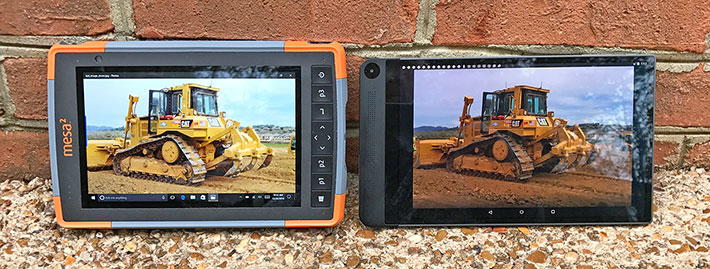
When viewed from an angle, the Mesa 2 retained good viewability and did not suffer from contrast or color shifts. We did, however, notice a slight yellow/blue tinge change when viewing the Mesa 2 display from different angles.
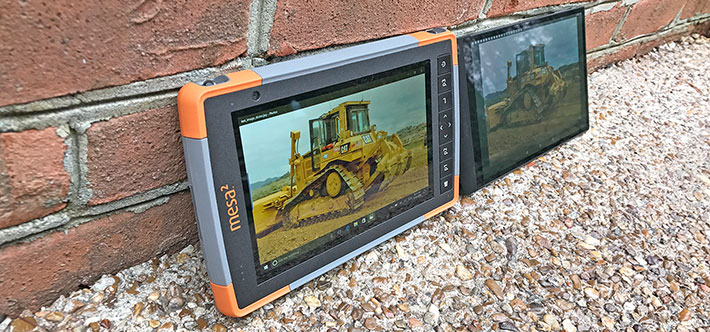
Touch
When Apple introduced the iPhone almost ten years ago, virtually no one expected it to change the world as drastically as it did. Not only did the iPhone bring upon the global smartphone revolution, but it also brought capacitive multi-touch with its effortless tapping, panning, pinching and zooming. Capacitive multi-touch was such a quantum leap forward that the technology simply took over the consumer space and quickly made anything else feel clumsy and dated.
This put manufacturers of rugged and industrial handhelds and tablets into a difficult position. On the one hand, inexpensive consumer tech began encroaching into their territory and there was substantial pressure to offer that elegant capacitive multi-touch in rugged devices as well. On the other hand, capacitive touch didn't work with gloves or in the rain, nor did it allow the level of precision necessary to work well with older operating systems that predated capacitive touch.
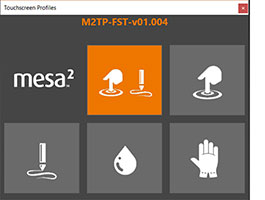 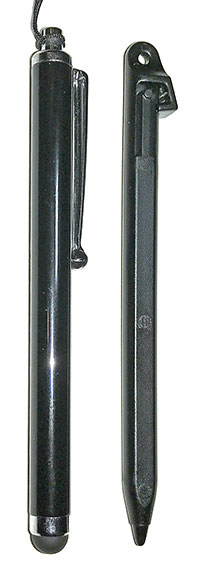 When we did a detailed review of the original Mesa (which used resistive touch and a passive stylus), we discussed all this with Juniper. The company felt that capacitive touch would continue to improve and that they would experiment with the technology until it became suitable for rugged work environments.
When we did a detailed review of the original Mesa (which used resistive touch and a passive stylus), we discussed all this with Juniper. The company felt that capacitive touch would continue to improve and that they would experiment with the technology until it became suitable for rugged work environments.
Capacitive touch did improve, and so the Mesa 2 has capacitive multi-touch. And Juniper handled the glove and wetness issues via touchscreen profile settings that configure the Mesa 2 for use with finger and stylus (the default), just finger, just stylus, with gloves on or for use in wet conditions.
It does get a bit confusing here. The Mesa 2 actually comes with two pens. One has a hard, narrow tip that's only about 1/12th of an inch wide and allows fairly precise operations, like selecting the small objects that continue to be part of the desktop/legacy mode of Windows 1. The other is a much wider soft-tipped stylus, the kind that looks like a rounded pencil eraser and is often used to tap on iPads and Android tablets.
Why two different styli? Because the narrow-tipped one doesn't work when wet mode is selected. Here are the Mesa 2's different touchscreen profiles:
- Pen or touch: Finger and both pens are recognized.
- Touch: For use with fingers or to some extent the soft-tipped stylus. This likely works by ignoring anything but the large touch area of a finger or soft stylus with a wide tip.
- Pen only: For use with the narrow tip pen. This mode is good for drawing or writing, or whenever you don't want your fingers to inadvertently trigger an action. Juniper probably work made that work by ignoring touch signals above a certain size. Interestingly, a regular pencil or some narrow-tip metal styli also work, but not a narrow plastic stylus.
- Glove touch: This mode makes the touch display with some (but not all) gloves. Thickness and texture matters. This mode probably increases the sensitivity of the touch controller. It doesn't work with the narrow-tip pen.
- Wet mode: That's the profile to use when it's raining or the tablet is used where it's subjected to water splashing. Technically, this could work by switching from the standard mutual capacitance to self-capacitance. The former measures the capacitance between two or more touch areas, which doesn't work properly when droplets of water fall onto the display. The latter measures the capacitance between one electrode and the ground, making multi-touch impossible.
We don't know how exactly Juniper implemented the wet mode, but their rain profile works indeed very well. Well enough to make working in the rain possible. For a quick demonstration, see this Juniper YouTube video.
So what do we make of all that? Essentially that just like making today's display technology work outdoors and in sunlight requires some compromises and isn't perfect, the same applies to capacitive touch. It's now possible to make it work under more conditions, but there are still limitations. We also wish switching between profile would be quicker (it takes about 20 seconds).
The big picture is this: when Apple introduced capacitive multi-touch, it introduced it together with software and a user interface designed from scratch for capacitive multi-touch. Android, likewise, was designed from scratch for capacitive multi-touch. Windows, on the other hand, wasn't. So the big challenge remains, even under Windows 10, how best to do with a small tablet the precise, detailed work that's been done for decades with keyboard and mouse. It is a compromise and will remain one for some time to come. But Juniper certainly did its part to make things work as well as they currently can.
Integrated cameras
Cameras have had a weird relationship with mobile computers over the years. Camera attachments for them were available even in the early days of Pocket PCs, and integrated cameras have been common in industrial handhelds for many years. The quality of almost all of those imaging systems, however, was nowhere near that of even low-end dedicated cameras, and so their value for both communication (video conferencing) and, especially, documentation was limited.
The situation changed drastically with the advent of modern smartphones whose increasingly competent cameras have almost wiped out the traditional point-and-shoots (we shot most of the product photography for this review with an Apple iPhone 7Plus). 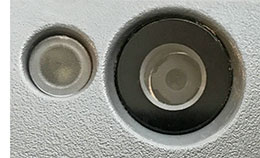 Cameras built into rugged handhelds and tablets lagged behind in quality compared to those in consumer smartphones, but they are now catching up. To the extent where they are now becoming increasingly usable for documentation work. Cameras built into rugged handhelds and tablets lagged behind in quality compared to those in consumer smartphones, but they are now catching up. To the extent where they are now becoming increasingly usable for documentation work.
What does the Mesa 2 offer in terms of imaging? That would be a 2-megapixel user-facing camera for video calls and such, and a rear-mounted 8-megapixel camera with LED flash for documentation tasks. These resolutions are perfectly adequate for the tasks they are expected to perform. Unfortunately, a cameras are often only as good as their user interface.
Here the Mesa 2 users rely entirely on the Microsoft Windows 10 Camera apps which, by definition, must support every camera users might have or connect to their PC. As a result, Microsoft's own Windows Camera app listing cautions that some features are "available only on select devices." On the Mesa 2 that means that white balance, focus control, ISO, shutter, exposure correction, timer, and flash. Users can also select from photo, panoramic photo and video. The images below show the Windows Camera user interface with its needlessly tiny controls.

We did not find a way to adjust image size other than setting the aspect ratio either to 4:3 or 16:9. The latter in 2,364 x 1,836 pixel images, or 6 megapixel. In video mode, users can select from 1920 x 1080, 1280 x 720 or 960 x 540, all at 30 frames per second. Digital video stabilization is available.
As is, the Mesa 2's cameras are world's ahead of where cameras integrated into handhelds used to be just a few years ago. With a bit of practice they are absolutely good enough for most documentation work on the job. This can eliminate the need to take along a separate camera, and it also means that applications, captured data and supporting imagery will all be in the same device.
That said, we wish the stock, generic Windows Camera app would offer more features and options, so as to take full advantage of the imaging hardware built into the Mesa 2. Fortunately, we're starting to see more 3rd party camera applications in the Windows 10 store. Examples are Camera360 Sight, HDR Photo Camera, B612, and ProShot. We downloaded ProShot onto the Mesa 2, but couldn't get the app to run properly.
Below are some sample pictures we shot with the standard Windows Camera app. Click on the image compilation for a full size version.
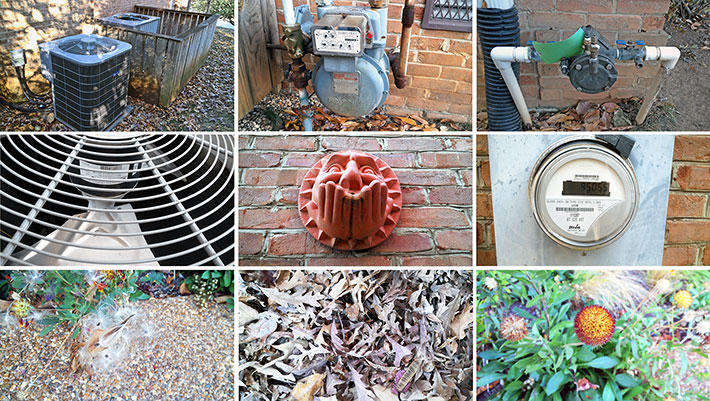
Wireless connectivity
The Mesa 2 Geo's positioning subsystem uses a professional grade 72-channel u-blox NEO-M8N GNSS module with 2 meter (6.6 feet) CEP. CEP stands for "circular error probable" and means that half of the time accuracy is within a radius of two meters from actual. It has integrated real-time SBAS capability, support for WAAS, MSAS, EGNOS and GAGAN, and is capable of tracking up to three of the four available GNSS systems concurrently, those being GPS (the US system), GLONASS (the Russian version of GPS), the European Galileo, and the Chinese BeiDou. This means almost triple the number of available satellites, which makes for quick starts, very good accuracy, and superior coverage.
Juniper offers the Mesa 2 with a variety of wireless options. Those include long-range (up to 60 feet) Bluetooth Smart Ready v4.0 + EDR, Class 1.5, BLE support, dual-band 802.11a/b/g/n WiFi, as well as 4G LTE (GSM or Verizon) mobile broadband via Sierra Wireless AirPrime EM7355 or EM7305 modules. The WWAN modules also support UMTS/HSPA+, CDMA 1xRTT/EV-DO Rev A and GSM/GPRS/EDGE.
For data acquisition, Juniper also offers the Mesa 2 with an integrated Zebra SE4710 1D/2D imager/PL3307C decoder and the Barcode Connector utility for scanner configuration, settings and testing. The barcode reader has a range from an inch to about two feet, depending on code and conditions.
The device can also be ordered with an RFID reader, which also comes with its own RFID Connector utility.
Docks and mounting
 Since many Mesa 2 rugged tablets will also be used in office settings, Juniper offers the Office Docking Station. The dock has three USB ports, an HDMI port, a gigabit RJ45 wired LAN jack, and a 12V DC power jack. Since many Mesa 2 rugged tablets will also be used in office settings, Juniper offers the Office Docking Station. The dock has three USB ports, an HDMI port, a gigabit RJ45 wired LAN jack, and a 12V DC power jack.
Juniper also offers a variety of mounting and attachment accessories. These include a survey/GPS pole clamp and mount, a vehicle mounting dock with its own onboard power and communications ports, a vehicle dock pole mount system, as well as a 4-point harness, a carrying case holster, travel charger, etc.
Ruggedness indeed
The Mesa 2 continues Juniper's tradition of ruggedness and sensible, practical technology. Here's a look at the ruggedness specs that matter most:
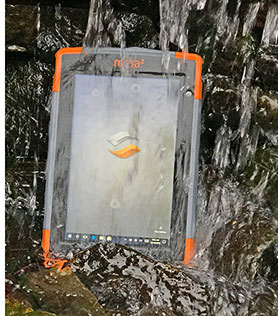
- For ingress protection, the Mesa rates a superior IP68. The first number stands for protection against solids. 6 is as high as it gets, and it means the unit is totally protected against the finest dust.
The second number is for the degree of protection from liquids. That scale goes from 0 (no protection) to 8. The MESA 2's "8" liquid protection rating means the device is protected against long periods of immersion. It's up to the manufacturer to report how deep and how long. Juniper tested the Mesa 2 for two hours at 1.4 meters (4.6 feet).
- The Mesa has a wide operating temperature range of -4 to 122 degrees Fahrenheit.
While not quite as extreme as that of the Archer 2 ultra-rugged handheld (which can go as low as -22 degrees Fahrenheit and as high as 140 degrees), this makes the Mesa 2 suitable for deployment in just about any environmental setting, even freezers.
- As far as the ever-popular drop testing goes, the Mesa 2 survives multiple drops from four feet onto concrete. That's also a bit less than the super-rugged Archer 2, but remarkable considering that the Mesa 2 is a larger, heavier device with a much larger display.
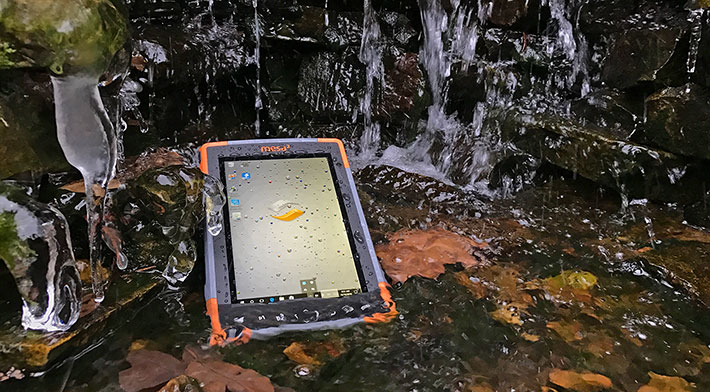
Juniper indicates that additional testing was performed according to MIL-STD-810G procedures: Method 500.5 Low Pressure (Altitude); Method 503.5 Temperature Shock; Method 506.5 Rain; Method 507.5 Humidity; Method 510.5 Sand and Dust; Method 512.5 Immersion; Method 514.6 Vibration.
There are few caveats we have regarding Mesa 2 ruggedness. Whereas with the initial Mesa, we cautioned that its many seals all had to be in perfect condition for optimal protection, the Mesa 2 only has one seal to watch, the main one between the two halves of the device. Between that and the absence of rubber plugs that must be in place, the Mesa 2 seems very well protected indeed. One thing we noted were a couple of small scratches in what we thought was pretty invulnerable Dragontrail glass. We don't know how that happened, but we'd rather not see that.
Overall, the Mesa 2 is a super-tough device, just like every other Juniper product we ever tested. Zero concerns here.
Mesa 2 HazLoc version
Working out there in the field can mean just that, in the field. But it can also mean working in location where hazardous materials are present. Working with electronic equipment in such potentially hazardous location — or "HazLoc" — areas may require special equipment certification. That's because electronic equipment can ignite flammable materials.
 Juniper offers a special HazLoc version of the Mesa 2 that's certified to be used in certain hazardous areas under certain conditions. Certification includes: Juniper offers a special HazLoc version of the Mesa 2 that's certified to be used in certain hazardous areas under certain conditions. Certification includes:
- Class I, Division 2, Groups A, B, C and D
- Class II, Division 2, Groups F and G
- Class III
- Temperature Code: T4
Now what does that mean?
In HazLoc speak there are Classes, Divisions and Groups. Class I applies to areas where flammable gasses are present, Class II where flammable dust is present, and Class II where flammable fibers are present. Division 1 means such flammables are always present, Division 2 means they are only there for brief periods of time. Groups describe what kinds of materials may be present.
For gasses, Group A is acetylene and similar, Group B hydrogen and similar, Group C ethylene and similar, and Group D propane and similar. For dusts, Group F is carbon-type whereas Group F is flour, grains, wood and such. In addition, there are temperature codes, which means the device must not ever exceed the ignition temperatures of materials. T4 means 275 degrees Fahrenheit. These are just the basics. For use in any hazardous area, certification requirements must be meticulously researched and observed.
Juniper Mesa 2: Bottom line
What does Juniper Systems' Mesa 2 mean in the larger scheme of things? Traditionally, providers of rugged mobile computing gear have either concentrated on handhelds or on laptops and other larger devices. There has been relatively little overlap. However, things are changing, what with handhelds, driven by smartphone trends, getting ever larger, and tablets coming in all sizes. Then there's Microsoft's Windows 10 "Universal Application" software platform with a common Windows core, essentially obliterating the software differentiation between handheld and larger devices. And also, finally, offering a feasible, modern Microsoft alternative to Android.
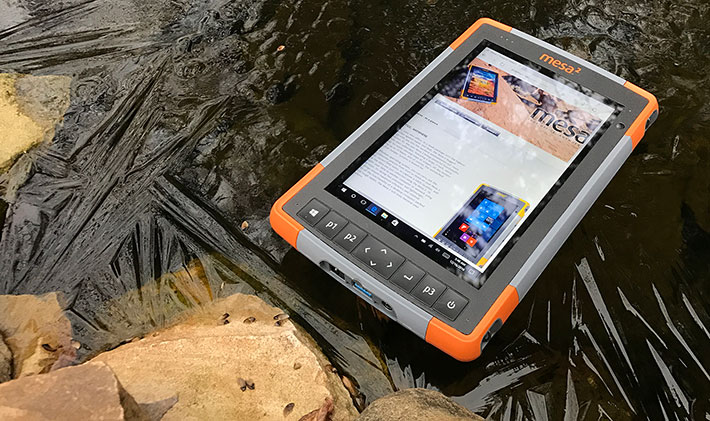
So that is what the Mesa 2 is for, allowing traditional Windows Mobile customers who need a more modern OS and a bigger screen continue with Microsoft and also with a company they have come to know and trust.
As for the hardware itself, it's Juniper through and through, which means practical, reliable, tough as nails, and designed and built with that common sense that's so often lacking in consumer market products.
On the technical side, the Mesa 2 is a supremely competent, very configurable, Intel Bay Trail-powered 7-inch capacitive multi-touch tablet with a sharp, bright display, excellent battery life, and the kind of trust-inspiring ruggedness and sealing that means field workers won't have to baby their gear. -- Conrad H. Blickenstorfer, December 2016
|
Juniper Systems Mesa 2 specifications:
|
|
Added/changed
|
Added 01/2016; full review 12/2016
|
|
Form-factor
|
Rugged tablet computer
|
CPU
|
Quad-core Intel Atom Z3745
|
CPU Speed
|
1.33 GHz (1.86GHz burst speed)
|
Cooling
|
Passive cooling, fanless design
|
OS
|
Windows 10
|
Standard/Max RAM
|
4GB/4GB LPDDR3
|
Disk/drive
|
64GB or 128GB Flash storage options
|
Card slots
|
User-accessible SD/SDXC Card
|
Display type
|
High visibility Illumiview backlit TFT with Dragontrail glass
|
Display size/res
|
7.0"/1280 x 800 (portrait or landscape)
|
Digitizer/pens
|
Projected capacitive multi-touch, glove and wet-capable, narrow-tip stylus
|
Keyboard/keys
|
LED-backlit directional keys, 3 function keys, Windows, power, enter
|
Navigation
|
touch, stylus, 4-way nav pad
|
Housing
|
Polycarbonate siloxane copolymer blend with overmolded bumpers
|
Operating Temp
|
-4° to 122°F (-20° to 50°C)
|
Sealing
|
IP68 (test: 2 hours at 1.4 meters)
|
Shock
|
Multiple drops from 4' (1.2 m) onto concrete
|
Humidity
|
MIL-STD-810G Method 507.5
|
Vibration
|
MIL-STD-810G Method 514.6
|
Sand and dust
|
MIL-STD-810G Method 510.5
|
Altitude
|
MIL-STD-810G Method 500.5 Low Pressure
|
Certifications
|
FCC Class B, CE Marking (applicable EMC, R&TTE, and LVD directives), Industry Canada, EN60950 Safety, RoHS 2 Compliant
|
Size (WxHxD)
|
5.4 x 8.5 x 1.4 inches (137 x 215 x 35 mm)
|
Weight
|
1.5 to 2.0 pounds (680 to 901 grams) depending on battery configuration
|
Power
|
Removable 39 watt-hour Li-Ion ("8-10 hrs."), optional internal 19 watt-hour (adds hot-swap and 4-5 hours)
|
Interface
|
1 x USB 3.0, 3.5mm audio, dock (power, USB 2.0, HDMI), power, optional RS232 DB9 serial, dual mics, speaker
|
GPS
|
uBlox NEO-M8N GPS with integrated real-time SBAS (WAAS, EGNOS, etc.) and external antenna pass-through
|
Camera (GEO models)
|
Front: 2mp, rear: 8mp with LED illumination, geotagging
|
Intrinsic safety
|
Special Mesa 2 HazLoc model: Class I, Division 2, Groups A, B, C and D; Class II, Division 2, Groups F and G; Class III; Temperature Code: T4
|
Wireless
|
Options: Long-range Bluetooth Smart Ready v4.0 + EDR, Class 1.5, BLE support, dual-band 802.11a/b/g/n WiFi, 4G LTE (GSM or Verizon)
|
List price
|
Inquire
|
Webpage
|
Mesa 2 page on Juniper's website
|
Spec sheet
|
Mesa 2 spec sheet (PDF)
|
Contact
|
www.junipersys.com or call 1.435.753.1881
|
|
(copyright 2016 RuggedPCReview.com)
Juniper Systems, Inc.
1132 West 1700 North
Logan, UT 84321 USA
Tel: 435-753-1881
Fax: 435-753-1896
Web: www.junipersys.com
Email: sales @ junipersys.com
|






